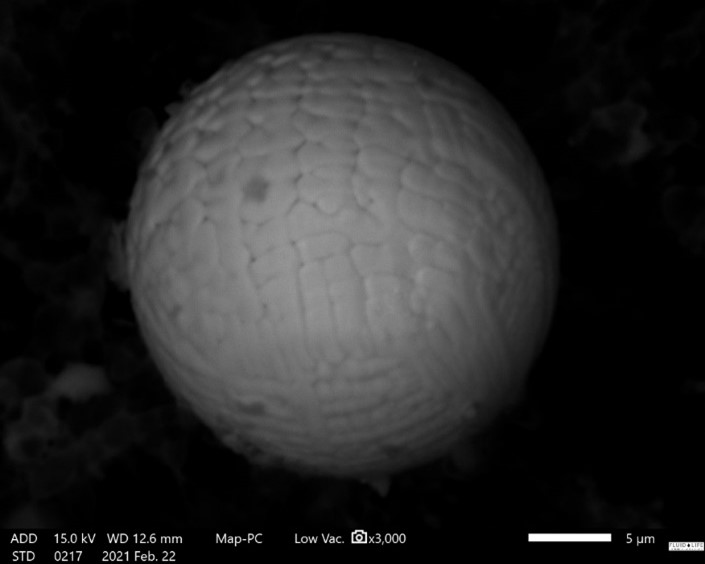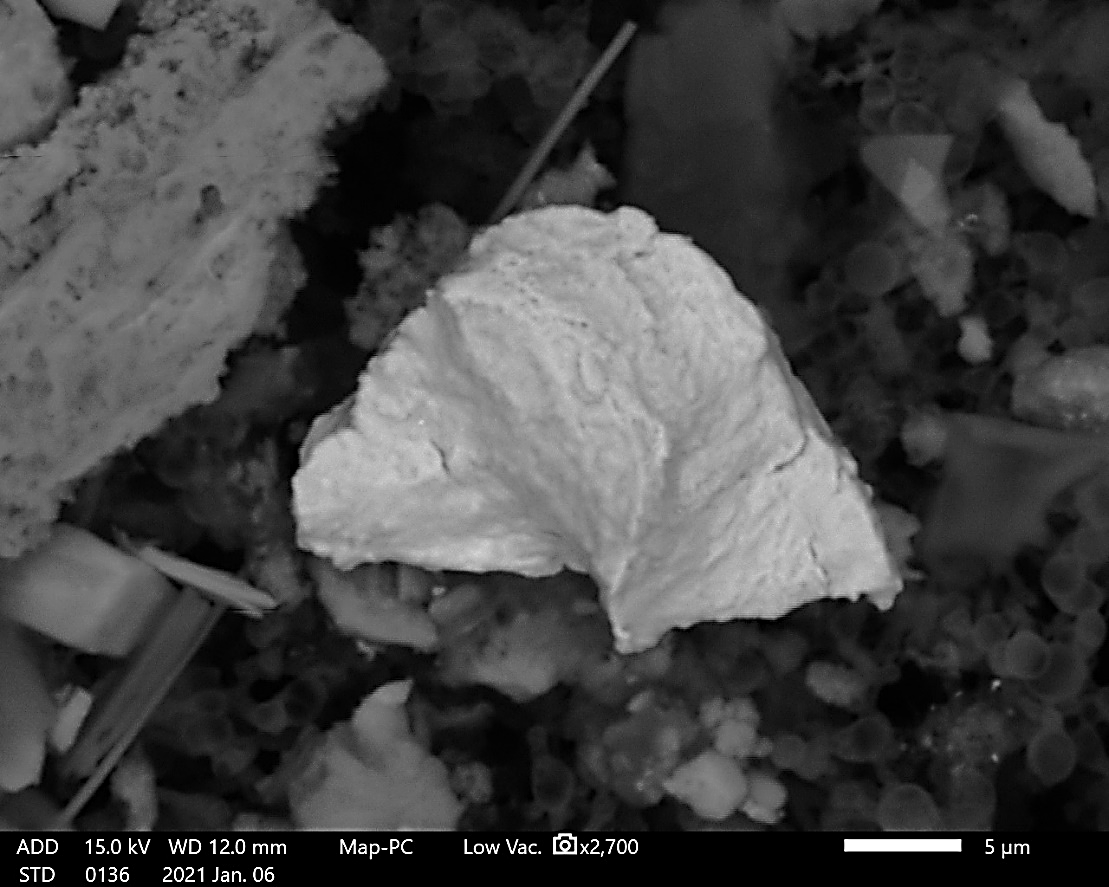
Large particle analysis is a critical, but often neglected, element of an effective oil analysis and condition monitoring program.
ICP/AE spectrometers have a well-known lack of sensitivity to particles greater than approximately 5-10 microns. Particles >10um are effectively invisible to a spectrometry based oil analysis program.
These large particles (>10um) provide critical information about machine health, component wear and contamination and are often considered an early warning of abnormal wear, bearing fatigue and transmission failure.
SEM-EDS Wear Debris Analysis
When the results from ICP/AE spectrometers are not enough to identify the cause of a wear or contamination issue, you should consider Scanning Electron Microscopy – Energy Dispersive Spectroscopy (SEM-EDS) analysis from Fluid Life. SEM-EDS can be used as a holistic tool for evaluating oil, greases, filter media, and magnetic plugs.
The wear debris and large particle analysis completed through Fluid Life’s SEM-EDS analysis is far superior in determining the size and composition of hundreds of particles per sample in lubricating oil, grease, filters, and process materials. It can provide a clearer picture of contamination and wear versus traditional SEM which is limited to only a handful of particles per sample, can be cost prohibitive, and is impractical for routine usage.
SEM/EDS analysis offered by Fluid Life is an effective method of wear debris monitoring to help prevent equipment failures, minimize downtime and reduce costs.
Advantages of SEM-EDS Analysis

- Detects Large Particles missed by spectrometry
- Determines size, elemental composition
- Detects abnormal wear modes including spheres, cutting and fatigue wear
- Determine the cause and source of Copper wear: Differentiate between cooler core leach, bearing wear and bushing wear.
- Monitor the progression of bearing wear through multi-layer bearings and monitor bearing overlay, nickel barriers, intermediate layers and abnormal wear into the support shell.
- Differentiate Aluminum wear from outside contamination
- Perform accurate particle counts on in-service Diesel Engine Oils
- Monitor Cleanliness and Contamination against baselines and target
This method and world class laboratory automation enables complete SEM analysis and critical component protection to become a cost-effective pillar of your ROUTINE condition monitoring program.
SEM-EDS Analysis Options & Resources
TMI
Particle Detection Range
>40um
Particle Count
N/A
Particle Sizing
N/A
Particle Shape Classification
N/A
Elemental Composition of Individual Particles
N/A
Elemental Chemical Analysis Range
Ferrous Debris Only
OPC/ISO
Particle Detection Range
4um – 150um
Particle Count
Yes
Particle Sizing
Yes
Particle Shape Classification
Limited to OPC
Elemental Composition of Individual Particles
N/A
Elemental Chemical Analysis Range
None
ICP
Particle Detection Range
~0um – 10um
Particle Count
N/A
Particle Sizing
N/A
Particle Shape Classification
N/A
Elemental Composition of Individual Particles
N/A
Elemental Chemical Analysis Range
26 Elements
XRF
Particle Detection Range
All
Particle Count
N/A
Particle Sizing
N/A
Particle Shape Classification
N/A
Elemental Composition of Individual Particles
N/A
Elemental Chemical Analysis Range
~50 – 90 Elements
Ferrography
Particle Detection Range
>10um
Particle Count
N/A
Particle Sizing
Limited
Particle Shape Classification
Yes
Elemental Composition of Individual Particles
Visual Subjective
Elemental Chemical Analysis Range
N/A
SEM-EDS
Particle Detection Range
>0.1um
Particle Count
Yes
Particle Sizing
Yes
Particle Shape Classification
Yes
Elemental Composition of Individual Particles
Yes
Elemental Chemical Analysis Range
~50 – 90 Elements
SEM-EDS Analysis General Applications include:
- Critical Asset Monitoring
- Life Cycle Monitoring
- Break-in wear vs. metallurgical wear anomaly
- Mid-life routine
- End-of-warranty
- End-of-life
- Post Failure Analysis
- Component Life Extension Projects
- Particle count + cleanliness
- Filter efficiency
- Monitor wear progression
- Warranty
- Start-of-warranty
- Ongoing compliance
- End-of-warranty
- Pre-purchase Analysis
- Extended Drain Interval
- Monitor for evidence of abnormal wear or contamination
- Troubleshooting
- Follow-up on results from oil analysis, inspections, routine maintenance, sensors, operating condition, or alarms
- Monitor and confirm sensor data
SEM-EDS Analysis Engine Applications include:
- Extended Drain Interval
- Particle count and size
- Monitor wear progression
- Indicate abnormal wear
- Monitor Ingress of Contamination (Low – Moderate Dusting)
- Particle count and size
- Abnormal wear
- Life-Cycle Monitoring
- Break-in wear vs. metallurgical wear anomaly
- Mid-life routine
- End-of-warranty
- End-of-life
- Component Life Extension
- Particle count and cleanliness
- Detect wear and particles invisible to routine analysis (particles >10um)
- Detect early warning of abnormal wear
- Detect bearing wear, underlay, electric discharge spheres, high alloy steel, and valve wear
- Filter and Spinner Analysis
- Particles hidden from your routine oil analysis
- Requires trending and consistency
- Troubleshooting
- Follow-up oil analysis results (triggered or requested)
- Follow-up from sensor results, alarms, inspections, or maintenance
- Follow-up on operating conditions
- Determine if copper is wear or leaching
- Fuel injector / exhaust valve (Inconel alloy)
SEMO
Basic Oil
Sample Type
Oil
SEM Analysis
Mostly Automated
Outputs
Basic Report
SEM micrographs, particle count & classification, observations, and Reliability review
Sample Volume
20mL
Turnaround
3 Days
SEMX
Basic Other
Sample Type
Filters, Spinner Filters, Grease
SEM Analysis
Mostly Automated
Outputs
Basic Report
SEM micrographs, particle count & classification, observations, and Reliability review
Sample Volume
20mL
Turnaround
3 Days
SEMS
Manual Analysis
Sample Type
Any suitable sample – specific situational analysis
SEM Analysis
Manual
Outputs
Variable – based on requirements
Includes SEM micrographs, particle count & classification, observations and Reliability review
Structured to address a specific concern
Sample Volume
20mL
Turnaround
Variable – depends on scope of project
Additional Insights
Case Study
Fluid Life’s SEM-EDS Analysis is far superior for determining the size and composition of particles in a sample. Get information about machine health, component wear and contamination in a single test.
But what do the reports and results look like? How do they relate to results on routine analysis reports? Do they make decision-making easier?
Get the Interpreting SEM-EDS Results case study which takes a look at some real-world SEM-EDS analyses conducted for one of our mining customers in the Canadian Tundra.
Want more information about SEM-EDS?
Call: 1-877-962-2400
Talk to a Fluid Life Representative
